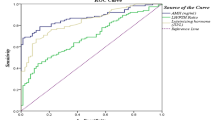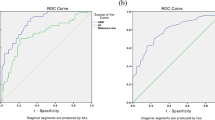Abstract
Purpose
Features of polycystic ovarian syndrome (PCOS) including sonographic aspects, androgens, LH and LH/FSH ratio as well as Anti-Mullerian Hormone (AMH) were evaluated according to their diagnostic potency in detecting different degrees of PCOS severity.
Methods
80 women with PCOS diagnosed according to the Rotterdam ESHRE/ASRM-Sponsored PCOS Consensus Workshop Group 2003 and 48 controls were enrolled between 2011 and 2013. PCOS patients fulfilling all Rotterdam criteria were defined as having severe PCOS (n = 59), while patients showing oligo-/amenorrhoea and polycystic ovaries but without hyperandrogenemia were defined as having mild PCOS (n = 21). All patients were treated at the University Hospital of Essen, Germany.
Results
The strongest group difference between controls and severe PCOS patients was observed for AMH showing an age-adjusted odds ratio of 2.56 [95 % confidence interval (CI) 2.00–3.27; p < 0.0001]. Age-adjusted receiver operating characteristic analysis showed that the area under the curve (AUC) of 0.88 (95 % CI: 0.80–0.95) for AMH and 0.94 (95 % CI 0.88–0.98) for antral follicle count did not differ significantly in their ability to discriminate between severe PCOS patients and controls. AMH showed higher AUC estimates than androgens, ovarian volume, LH and LH/FSH ratio and an AUC of 0.80 (95 % CI: 0.65–0.91) for detecting mild PCOS.
Conclusions
To our knowledge, this is the first study comparing the diagnostic potency of AMH, sonographic aspects, androgens, and LH/FSH ratio according to different PCOS subgroups while accounting for the age-dependency of AMH. In cases where vaginal scans are not feasible or in patients without hyperandrogenemia AMH may be used as a surrogate parameter in PCOS diagnosis, superior to androgens and gonadotropins.

Similar content being viewed by others
References
Azziz R, Woods KS, Reyna R, Key TJ, Knochenhauer ES, Yildiz BO (2004) The prevalence and features of the polycystic ovary syndrome in an unselected population. J Clin Endocrinol Metab 89(6):2745–2749
Michelmore KF, Balen AH, Dunger DB, Vessey MP (1999) Polycystic ovaries and associated clinical and biochemical features in young women. Clin Endocrinol (Oxf) 51(6):779–786
Rotterdam ESHRE/ASRM-Sponsored PCOS consensus workshop group (2004) Revised 2003 consensus on diagnostic criteria and long-term health risks related to polycystic ovary syndrome (PCOS). Hum Reprod 19(1):41–47
Pigny P, Merlen E, Robert Y, Cortet-Rudelli C, Decanter C, Jonard S, Dewailly D (2003) Elevated serum level of anti-mullerian hormone in patients with polycystic ovary syndrome: relationship to the ovarian follicle excess and to the follicular arrest. J Clin Endocrinol Metab 88(12):5957–5962
Pigny P, Jonard S, Dewailly D (2006) Serum anti-Mullerian hormone as a surrogate for antral follicle count for definition of the polycystic ovary syndrome. J Clin Endocrinol Metab 91(3):941–945
Dewailly D, Gronier H, Poncelet E, Robin G, Leroy M, Pigny P, Duhamel A, Catteau-Jonard S (2011) Diagnosis of polycystic ovary syndrome (PCOS): revisiting the threshold values of follicle count on ultrasound and of the serum AMH level for the definition of polycystic ovaries. Hum Reprod 26(11):3123–3129
Jonard S, Dewailly D (2004) The follicular excess in polycystic ovaries, due to intra-ovarian hyperandrogenism, may be the main culprit for the follicular arrest. Hum Reprod Update 10(2):107–117
Fanchin R, Schonäuer LM, Righini C, Guibourdenche J, Frydman R, Taieb J (2003) Serum Anti-Müllerian hormone is more strongly related to ovarian follicular status than serum inhibin B, estradiol, FSH and LH on day 3. Hum Reprod 18(2):323–327
di Clemente N, Ghaffari S, Pepinsky RB, Pieau C, Josso N, Cate RL, Vigier B (1992) A quantitative and interspecific test for biological activity of anti-müllerian hormone: the fetal ovary aromatase assay. Development 114(3):721–727
Wetzka B, Textor W, Ochsner A, Geisthövel F (2011) Anti-Mullerian hormone confirms the novel classification of female functional androgenization including polycystic ovary syndrome. Eur J Endocrinol 165(2):323–330
Woo HY, Kim KH, Rhee EJ, Park H, Lee MK (2012) Differences of the association of anti-Müllerian hormone with clinical or biochemical characteristics between women with and without polycystic ovary syndrome. Endocr J 59(9):781–790
Nardo LG, Yates AP, Roberts SA, Pemberton P, Laing I (2009) The relationships between AMH, androgens, insulin resistance and basal ovarian follicular status in non-obese subfertile women with and without polycystic ovary syndrome. Hum Reprod 24(11):2917–2923
Piouka A, Farmakiotis D, Katsikis I, Macut D, Gerou S, Panidis D (2009) Anti-Mullerian hormone levels reflect severity of PCOS but are negatively influenced by obesity: relationship with increased luteinizing hormone levels. Am J Physiol Endocrinol Metab 296(2):E238–E243
Dewailly D, Pigny P, Soudan B, Catteau-Jonard S, Decanter C, Poncelet E, Duhamel A (2010) Reconciling the definitions of polycystic ovary syndrome: the ovarian follicle number and serum anti-Müllerian hormone concentrations aggregate with the markers of hyperandrogenism. J Clin Endocrinol Metab 95(9):4399–4405
Iliodromiti S, Kelsey TW, Anderson RA, Nelson SM (2013) Can Anti-Mullerian Hormone predict the diagnosis of polycystic ovary syndrome? A systematic review and meta-analysis of extracted data. J Clin Endocrinol Metab 98:3332–3340
Li Y, Ma Y, Chen X, Wang W, Li Y, Zhang Q, Yang D (2012) Different diagnostic power of anti-Mullerian hormone in evaluating women with polycystic ovaries with and without hyperandrogenism. J Assist Reprod Genet 29(10):1147–1151
Matthews DR, Hosker JP, Rudenski AS, Naylor BA, Treacher DF, Turner RC (1985) Homeostasis model assessment: insulin resistance and beta-cell function from fasting plasma glucose and insulin concentrations in man. Diabetologia 28:412–419
Jensterle M, Weber M, Pfeifer M, Prezelj J, Pfutzner A, Janez A (2008) Assessment of insulin resistance in young women with polycystic ovary syndrome. Int J Gynaecol Obstet 102:137–140
Balen AH, Laven JS, Tan SL, Dewailly D (2003) Ultrasound assessment of the polycystic ovary: international consensus definitions. Hum Reprod Update 9(6):505–514
Norris CM, Ghali WA, Saunders LD, Brant R, Galbraith D, Faris P, Knudtson ML, Investigators APPROACH (2006) Ordinal regression model and the linear regression model were superior to the logistic regression models. J Clin Epidemiol 59(5):448–456
Pepe M, Longton G, Janes H (2009) Estimation and comparison of receiver operating characteristic curves. Stata J 9(1):1
Youden WJ (1950) Index for rating diagnostic tests. Cancer 3:32–35
R Core Team. R: A language and environment for statistical computing. R Foundation for Statistical Computing, Vienna, Austria ISBN 3-900051-07-0, URL: http://www.R-project.org/
Mahran A, Abdelmeged A, El-Adawy AR, Eissa MK, Shaw RW, Amer SA (2013) The predictive value of circulating anti-mullerian hormone in women with polycystic ovarian syndrome receiving clomiphene citrate: a prospective observational study. J Clin Endocrinol Metab 98(10):4170–4175
Han X, McShane M, Sahertian R, White C, Ledger W (2014) Pre-mixing serum samples with assay buffer is a prerequisite for reproducible anti-Mullerian hormone measurement using the Beckman Coulter Gen II assay. Hum Reprod 29(5):1042–1048
Azziz R, Carmina E, Dewailly D, Diamanti-Kandarakis E, Escobar-Morreale HF, Futterweit W, Janssen OE, Legro RS, Norman RJ, Taylor AE, Witchel SF (2006) Androgen Excess Society. Positions statement: criteria for defining polycystic ovary syndrome as a predominantly hyperandrogenic syndrome: an Androgen Excess Society guideline. J Clin Endocrinol Metab 91(11):4237–4245
Acknowledgments
The authors would like to thank the laboratory staff for the support and continual help in analyzing the samples, their storage and documentation of data, especially Gisela Koestner, Jens Rasch, Ute Kirsch and Sieglinde Arndt. We further are grateful to the nurses of University Hospital Essen, Department Obstetrics, for obtaining the patient samples, especially Erika Naber, Angelika Hover and Aileen Balser. We are also grateful to all women who took part in this study.
Conflict of interest
The authors declare that they have no conflict of interest.
Author information
Authors and Affiliations
Corresponding author
Rights and permissions
About this article
Cite this article
Köninger, A., Koch, L., Edimiris, P. et al. Anti-Mullerian Hormone: an indicator for the severity of polycystic ovarian syndrome. Arch Gynecol Obstet 290, 1023–1030 (2014). https://doi.org/10.1007/s00404-014-3317-2
Received:
Accepted:
Published:
Issue Date:
DOI: https://doi.org/10.1007/s00404-014-3317-2




